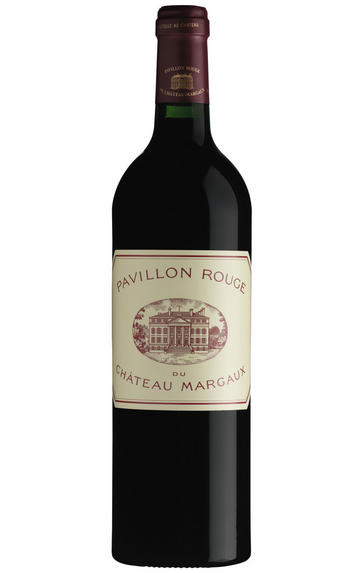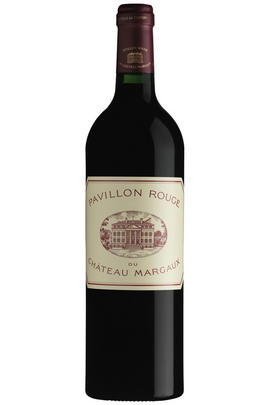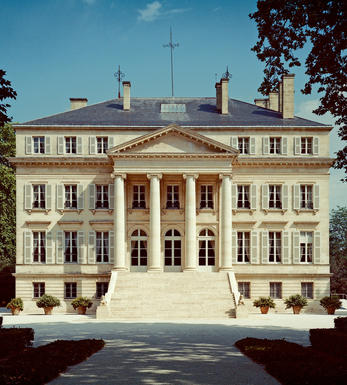
2022 Pavillon Rouge du Château Margaux, Margaux, Bordeaux

Critics reviews
The 2022 Pavillon Rouge, which represents 32% of the production this year, has a highly perfumed nose with wilted violets chaperoning the copious black fruit. Wonderful definition. The palate is medium-bodied with fine boned tannins. Silky smooth and sensual, with a mineral-driven finish, this sashays along in style. One of the few 2022's whose barrel sample is so seductive I could have eloped with it there and then.
Drink 2026-2048
Neal Martin, Vinous.com (May 2023)
The 2022 Pavillon Rouge du Chateau Margaux is made from 64% Cabernet Sauvignon, 24% Merlot, 7% Petit Verdot, and 5% Cabernet Franc. Deep garnet-purple in color, it needs quite a lot of swirling to bring out notes of blackcurrant pastilles, Morello cherries, and preserved plums, followed by hints of dusty soil, cumin seed, and garrigue. The medium to full-bodied palate delivers commendable grace and backbone, with firm grainy tannins and well-knit freshness supporting the muscular black fruits, finishing with a fragrant lift. pH 3.65, TPI 85, alcohol 14.8% - but you don't feel it.
Drink 2027-2049
Lisa Perrotti-Brown MW, The Wine Independent (May 2023)
Glass-staining inky purple, fleshy damson and cassis fruits with spice and concentration. Captures the spirit of the vintage with plush damson fruits, edges of sweet spices and gunsmoke, but keeps the understated pleasure that Margaux specialises in, with soft peony aromatics. High Petit Verdot in this blend because using the 2% that normally goes into the first wine but is kept out in 2022. No pumping over, with director Philippe Bascaules making the choice to let extraction happen gently, with minimal intervention. 32% of the crop in Pavillon, 25hl/h yield. 60% new oak (although this sample is 100%), and clear need to be cautious with oak during ageing.
Drink 2028-2042
Jane Anson, JaneAnson.com (April 2023)
Jancis Robinson MW, jancisrobinson.com (May 2023)
William Kelley, Wine Advocate (April 2023)
Rich and dense with lots of fruit and juiciness. Redcurrants, black berries, strawberries and orange peel on the nose. Full and layered with fine, velvety tannins and a juicy finish. Big presence.
James Suckling, JamesSuckling.com (April 2023)
Beautiful vivid colour, bright and intense. Dark chocolate, cherries and subtle perfume on the nose. Bright and lively thought also lean and straight on the palate. A generous weight and intense grip to the tannins. It’s on the tense side, focussed with extreme precision to the fruit profile with racy acidity unpinning the tannins which are at the fore. Feels refined and elegant, more serious than some other second wines in its construction but is classy, juicy, sculpted and softly plush. The fruit has bite and tang, with liquorice and graphite edges and spiced accents giving angles but all enjoyable and really building to the whole. Great freshness and length.
7% Petit Verdot completes the blend. 3.61pH. 84 IPT - highest IPT, highest before was 2018 which was 82. 15% press wine. 31% production.
Drink 2028-2048
Georgina Hindle, Decanter (April 2023)
You could easily mistake the 2022 Pavillon Rouge De Margaux for the Grand Vin here, and truth be told, I wouldn’t be surprised to see this actually evolve better than some of the Grand Vins from just over 10-15 years ago. A blend of 64% Cabernet Sauvignon, 24% Merlot, 7% Cabernet Franc, and the rest Petit Verdot (the second wine got all the Petit Verdot in 2022), it offers a deep, medium to full-bodied, seamless profile as well as solid framboise, darker raspberry, currants, sandalwood, and spice aromatics, silky tannins, and outstanding length. The purity and precision paired with this level of texture and richness far exceeds the vast majority of second wines out there.
Jeb Dunnuck, JebDunnuck.com (May 2023)
About this WINE

Chateau Margaux
Château Margaux, a First Growth property, has been owned by the Mentzelopoulos family since 1978. It has since consistently produced some of the finest wines in the Médoc.
One of the grandest, most imposing buildings amongst the Médoc châteaux, Ch. Margaux in its current form was built in the early 19th century, although viticulture had been practised on the estate for several centuries before. A chequered period of ownership in the 19th and early 20th century meant that the quality of some vintages was patchy. But the change which restored the property to its rightful status came in 1977 when it was bought by André Mentzenopoulos, Greek by birth but who had lived in France since 1958 and had made a fortune through supermarket retailing. André immediately instigated much-needed investment in vineyard and cellar. His untimely death in 1980 saw his daughter, Corinne, take up the reins. Corinne’s shrewdest move was the recruitment of talented young winemaker Paul Pontallier to oversee the production.
Paul would lead the estate for 33 vintages. He sadly passed away in 2016. Today, the estate is overseen by director Philippe Bascaules and technical director Sebastien Vergne, working with consultant Eric Boissenot.
The estate has 82 hectares under vine, with Cabernet Sauvignon inevitably dominant (75%) with 20% Merlot making up most of the rest, along with a smattering of Cabernet Franc and Petit Verdot. Unusually in Margaux, there is a white wine made here, Pavillon Blanc, from 100% Sauvignon Blanc, while the two red wines are, of course, Ch. Margaux itself and Pavillon Rouge. Typically, about 30,000 cases of red wine are made, with the Grand Vin usually accounting for just over 40% of the total. Production of the white wine amounts to less than 3,000 cases.
Margaux wines are renowned for their perfumed elegance, but this should not be construed as meaning that these are light-bodied. Far from it, as the best have an enviable structure, layers of complexity, and formidable length.

Margaux
If Pauillac can be seen as the bastion of ‘traditional’ Red Bordeaux, then Margaux represents its other facet in producing wines that are among Bordeaux’s most sensual and alluring. It is the largest commune in the Médoc, encompassing the communes of Cantenac, Soussans, Arsac and Labaude, in addition to Margaux itself. Located in the centre of the Haut-Médoc, Margaux is the closest of the important communes to the city of Bordeaux.
The soils in Margaux are the lightest and most gravelly of the Médoc, with some also containing a high percentage of sand. Vineyards located in Cantenac and Margaux make up the core of the appelation with the best vineyard sites being located on well-drained slopes, whose lighter soils give Margaux its deft touch and silky perfumes. Further away from the water, there is a greater clay content and the wines are less dramatically perfumed.
Margaux is the most diffuse of all the Médoc appelations with a reputation for scaling the heights with irreproachable wines such as Ch. Margaux and Ch. Palmer, but also plumbing the depths, with too many other châteaux not fulfilling their potential. There has been an upward shift in recent years, but the appellation cannot yet boast the reliability of St Julien. However, the finest Margaux are exquisitely perfumed and models of refinement and subtlety which have few parallels in Bordeaux.
Recommended Châteaux: Ch. Margaux, Ch. Palmer, Ch. Brane-Cantenac, Ch. Rauzan-Ségla , Ch. Dufort-Vivens, Ch. Ferrière, Ch. du Tertre, Ch. Giscours, Ch. d'Angludet.

Cabernet Sauvignon Blend
Cabernet Sauvignon lends itself particularly well in blends with Merlot. This is actually the archetypal Bordeaux blend, though in different proportions in the sub-regions and sometimes topped up with Cabernet Franc, Malbec, and Petit Verdot.
In the Médoc and Graves the percentage of Cabernet Sauvignon in the blend can range from 95% (Mouton-Rothschild) to as low as 40%. It is particularly suited to the dry, warm, free- draining, gravel-rich soils and is responsible for the redolent cassis characteristics as well as the depth of colour, tannic structure and pronounced acidity of Médoc wines. However 100% Cabernet Sauvignon wines can be slightly hollow-tasting in the middle palate and Merlot with its generous, fleshy fruit flavours acts as a perfect foil by filling in this cavity.
In St-Emilion and Pomerol, the blends are Merlot dominated as Cabernet Sauvignon can struggle to ripen there - when it is included, it adds structure and body to the wine. Sassicaia is the most famous Bordeaux blend in Italy and has spawned many imitations, whereby the blend is now firmly established in the New World and particularly in California and Australia.


Buying options
Add to wishlist
Description
This tremendous second wine is very much a mirror to the grand vin with its intense tannins – again the highest ever, and evident in their texture and length. This assertive yet velvety note runs right through the palate, filling and coating the mouth. The fruit profile, of blackcurrant coulis, is succulent and seductive in its potential, and there are plenty of other dimensions working away beneath the surface: spice, sandalwood and peony. While representing the essence of the vintage, this may perhaps be a more typical Margaux than the grand vin itself. Either way, there is enormous pleasure to be found in this wine.
Cabernet Sauvignon 64%; Merlot 24%; Petit Verdot 7%; Cabernet Franc 5%
Drink 2028-2042
Score: 18/20
Berry Bros. & Rudd (April 2023)
wine at a glance
Delivery and quality guarantee